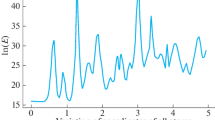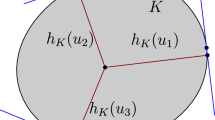Abstract
The concepts of global and local relative convexity and oriented relative convexity are described and proposed as tools for the characterization of molecular shapes. The usual concept of convexity is a special case of the generalization described. Oriented relative convexity is suitable for the characterization of molecular shapes in external fields, such as magnetic fields or fields representing cavity regions of various enzymes or zeolite catalysts. Potential applications include new approaches to computer-based drug design and molecular engineering.
Similar content being viewed by others
References
I.M. Yaglom and V.G. Boltyanskii,Convex Figures (Holt, Rinehart and Winston, New York, 1961).
A.V. Pogorelov,Extrinsic Geometry of Convex Surfaces (Amer. Math. Soc., Providence R.I., 1973).
W. Graham Richards,Quantum Pharmacology, 2nd Ed. (Butterworth, London, 1983).
P.A. Kollman, Ace. Chem. Res. 10(1977)365.
A. Verloop and J. Tipker, A comparative study of new steric parameters in drug design, in:Biological Activity and Chemical Structure, ed. J.A. Keverling Buisman, Pharmacochemical Library, Vol. 2 (Elsevier, Amsterdam, 1977).
R. Franke,Theoretical Drug Design Methods, Pharmacochemical Library, Vol. 7 (Elsevier, Amsterdam, 1977).
G.M. Maggiora and R.E. Christoffersen, Quantum mechanical approaches to the study of enzymic transition states and reaction paths, in:Transition States in Biochemical Processes, ed. R.D. Gandour and R.L. Schowen (Plenum, New York, 1978).
M.A. Johnson, V. Nicholson, M. Naim and C.-C. Tsai, in:QSAR in Drug Design and Toxicology, ed. D. Hadzi and B. Jerman-Blazic (Elsevier, Amsterdam, 1987).
A.J. Stuper, W.E. Brügger and P.C. Jurs,Computer-Assisted Studies of Chemical Structure and Biological Function (Wiley, New York, 1979).
J. Tomasi, On the use of electrostatic molecular potentials in theoretical investigations on chemical reactivity, in:Quantum Theory of Chemical Reactions, Vol. 1, ed. R. Daudel, A. Pullman, L. Salem and A. Veillard (Reidel, Dordrecht, 1979).
Y.C. Martin,Quantitative Drug Design: A Critical Introduction (Dekker, New York and Basel, 1978).
I. Motoc, Steric and other structural parameters for QSAR, in:Steric Fit in Quantitative Structure-Activity Relationships, ed. A.T. Balaban, A. Chiriac, A. Motoc and Z. Simon, Lecture Notes in Chemistry, No. 15 (Springer-Verlag, Berlin, 1980).
R. Carbó, L. Leyda and M. Arnau, Int. J. Quant. Chem. 17 (1980)1185.
G. Náray-Szabó, A. Grofcsik, K. Kosa, M. Kubinyi and A. Martin, J. Comput. Chem. 2(1981)58.
H. Weinstein, R. Osman, J.P. Green and S. Topiol, Electrostatic potentials as descriptors of molecular reactivity, in:Chemical Applications of Atomic and Molecular Electrostatic Potentials, ed. P. Politzer and D.G. Truhlar (Plenum, New York, 1981) pp. 309–334.
A. Warshel, Ace. Chem. Res. 14(1981)284.
P.H. Reggio, H. Weinstein, R. Osman and S. Topiol, Int. J. Quant. Chem. Quant. Biol. Symp. 8(1981)373.
M.L. Connolly, J. Mol. Graph 3(1985)19.
R.P. Sheridan, R. Nilakantan, J.D. Scott and R. Venkataraghavan, J. Med. Chem. 29(1986)899.
J.C. Culberson, G.D. Purvis III, M.C. Zerner and B.A. Seiders, Int. J. Quant. Chem. Quant. Biol. Symp. 13(1986)267.
S.D. Kahn, C.F. Pau, L.E. Overman and W.J. Hehre, J. Amer. Chem. Soc. 108(1986)7381.
G. Náray-Szabó and P.R. Surján, Computational methods for biological systems, in:Theoretical Chemistry of Biological Systems, ed. G. Náray-Szabó, Studies in Physical and Theoretical Chemistry, Vol. 41 (Elsevier, Amsterdam, 1986) pp. 1–100.
J. Aqvist and O. Tapia, J. Mol. Graph 5(1987)30.
P.G. Mezey, Int. J. Quant. Chem. Quant. Biol. Symp. 12(1986)113.
P.G. Mezey, J. Comput. Chem. 8(1987)462.
P.G. Mezey, Int. J. Quant. Chem. Quant. Biol. Symp. 14(1987)127.
G.A. Arteca and P.G. Mezey, Int. J. Quant. Chem. Quant. Biol. Symp. 14(1987)133.
G.A. Arteca, V. Jammal, P.G. Mezey, J.S. Yadav, M.A. Hermsmeyer and T. Gund, J. Mol. Graph 6(1988) 45.
E.H. Spanier,Algebraic Topology (MacDraw-Hill, New York, 1966).
M. Greenberg,Lectures on Algebraic Topology (Benjamin, New York, 1967).
S.-T. Hu,Elements of General Topology (Holden-Day, San Francisco, 1969).
J. Vick,Homology Theory (Academic Press, New York, 1973).
P.G. Mezey, J. Math. Chem. 2(1988)299.
P.G. Mezey, Theor. Chim. Acta 54(1980)95.
P.G. Mezey, Theor. Chim. Acta 63(1983)9.
P.G. Mezey,Potential Energy Hypersurfaces (Elsevier, Amsterdam, 1987).
G.A. Arteca and P.G. Mezey, to be published.
Author information
Authors and Affiliations
Rights and permissions
About this article
Cite this article
Mezey, P.G. Global and local relative convexity and oriented relative convexity; application to molecular shapes in external fields. J Math Chem 2, 325–346 (1988). https://doi.org/10.1007/BF01166299
Received:
Issue Date:
DOI: https://doi.org/10.1007/BF01166299




